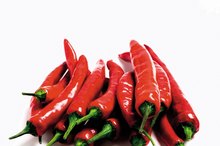How to Speed Up Your Metabolism to Make You Sweat More
You may not think of your body as a heat-generating machine, but, according to Georgia State University, your body gives off enough heat every day while burning calories to light a 100-watt bulb. When your body produces heat, it sweats to help keep you cool. Although genetics plays a role in determining your body's calorie-burning capacity, also known as metabolic rate, you can increase your burn rate and produce more heat and sweat. Consult your doctor before making changes to your diet or exercise routine.
Metabolism Basics
You eat food for energy. The amount of energy, or calories, your body needs a day is referred to as metabolic rate. Overall metabolic rate is determined by basal metabolic rate, daily activity and the thermic effect of food. The basal metabolic rate, or BMR, is the number of calories your body burns maintaining basic body functions such as breathing, and it's responsible for burning most of your daily calories. Activity includes the calories you burn exercising, as well as the calories burned doing day-to-day activities such as showering, getting dressed and walking to your car. The thermic effect of food includes the number of calories it takes for you to digest the food you eat. You actually burn 10 calories for every 100 calories you eat, according to the McKinley Health Center.
Build Muscle to Speed Up Metabolism
Thermogenics & Weight Loss
Learn More
In addition to breathing, your BMR also measures the number of calories burned by your muscles. According to McKinley, muscle is the biggest BMR calorie-burner. Building muscle can help speed up your metabolism.
Aim to work out all your major muscle groups -- legs, hips, back, arms, chest and stomach -- a minimum of two days a week. Free weights, resistance bands or body resistance exercises can help you add muscle to your body. To build muscle, sweat and gain the calorie-burning benefits, you need to do two to three sets of eight to 12 reps of each exercise. Ensure the last rep is so difficult you may need help to complete it.
High-Intensity Interval Training
Sweat more and get your metabolism going with high-intensity interval training, a type of aerobic exercise in which you alternate between periods of high-intensity exercise followed by periods of low-intensity exercise for a set amount of time. For example, you might ride a stationary bike at a very high intensity for 60 seconds, followed by 2 minutes at a low intensity, and repeat the activities eight times. You not only burn more calories during the workout, but afterwards as well, according to the American College of Sports Medicine, from excessive post-exercise oxygen consumption, or EPOC. During this two-hour post-workout period, your body is burning 6 to 15 percent more calories to recover and restore your body from the high-intensity workout.
Spicy Sweatin'
What Happens to Sugar Levels in the Blood While Fasting?
Learn More
Cayenne pepper not only causes you to sweat, referred to as "gustatory sweat," but it also revs up your metabolism. A 2012 report published in Chemical Senses says that cayenne pepper increases your metabolism by raising your body temperature. However, it's important to note that the spicy food may not burn a lot of calories, averaging only about 50 calories a day, according to the authors of the report, but every little bit helps when you're trying to give your metabolism a boost. Burning an extra 50 calories eating spicy cayenne pepper every day may help you lose 5 pounds in a year, as long you don't compensate by eating more calories from other food. Add dried cayenne pepper to your morning eggs, soup at lunch and steamed veggies at dinner for a little extra kick and calorie-burning. You can also slice the fresh pepper and add it your salad or favorite grain dish.
Related Articles
References
- Georgia State University: Metabolism
- MedlinePlus: Sweating
- Center for Disease Control and Prevention: How Much Physical Activity Do Adults Need?
- Australian Family Physician: Evidence Based Exercise - Clinical Benefits of High Intensity Interval Training
- Chemical Senses: The Effects of Capsaicin and Capsiate on Energy Balance: Critical Review and Meta-Analyses of Studies in Humans
Writer Bio
Jill Corleone is a registered dietitian and health coach who has been writing and lecturing on diet and health for more than 15 years. Her work has been featured on the Huffington Post, Diabetes Self-Management and in the book "Noninvasive Mechanical Ventilation," edited by John R. Bach, M.D. Corleone holds a Bachelor of Science in nutrition.









